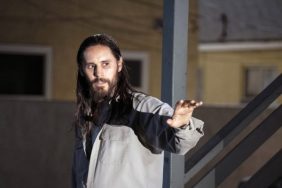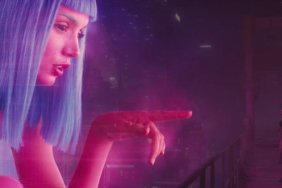Despite its current popularity at the box office, as a cinematic medium science fiction has never been duller. The compelling ideas that once drove the genre have been traded in for stylised space battles and not so witty one-liners and even proven hands in the genre have been stumbling. Just look at how the latest offerings from the likes of The Wachowski Siblings and Luc Besson have fallen flat with critics and at the box office.
Picking up 30 years after Ridley Scott’s seminal cerebral science fiction masterpiece Blade Runner (1982), Denis Villeneuve’s Blade Runner 2049 (2017) sets a different tone to its contemporaries. Trading space opera action for expressive atmosphere and rich world building, the film eschews our expectations of spectacle and bombast, centring instead on questions of the value and power of human life in a world in which it can be manufactured on an assembly line.
Before diving in, head here to get yourself a copy of the film, then join us below for an in-depth analysis.
The World Of 2049 Los Angeles
In the years following the events of the first film and preceding 2049, Replicants – artificial humans designed with enhanced strength and endurance for use as slave labour in off-world colonisation – rise up to fight for their freedom. The rebellions are put down and the production of Replicants is outlawed. The Tyrell Corporation, previously the most powerful entity in existence due to their monopoly on Replicant production, goes bankrupt and ceases operation.
The collapse of ecosystems in the 2020s then leads to the rise of industrialist Niander Wallace (Jared Leto) whose mastery of artificial farming allows humanity to cling to life on Earth a little longer. Wallace then acquires the remnants of the Tyrell Corporation and creates a new line of Replicants who obey. There are still older model Replicants on the loose though – Nexus 8s which have open-ended life spans – and so there are still Blade Runners; special LAPD Units tasked with ‘retiring’ (not killing, mind you) any Replicants that have gone rogue.
The dystopian world and rain drenched aesthetic may seem familiar – understandably considering the original gave us the defining vision of our near future gone to shit – yet what sets the film apart from its generic contemporaries is the way it allows the characters to drive the plot rather than the other way around.
More Human Than Human
These characters don’t just mindlessly respond to the circumstances around them. How they feel and how they see the world plays a huge part in determining the reality they face. Rather than being driven by a quest for a MacGuffin – although it sets itself up as such – the plot hinges on the subjectivity of each characters’ experience and how they interpret it and then chose to act.
Contrasting the stunning opening sequences of the original with the sequel, where Scott shows us a fire and brimstone vision of the 2019 Los Angeles skyline, its twinkling lights and belching flames reflected in a disembodied eye, Villeneuve shows us an eye with no reflection. Just an eye staring back at us. A witness. An audience.
When he then reveals to us the world of 2049 Los Angeles, instead of the industrial wasteland of the original we look down on fields of solar panels so perfectly placed they resemble a piece of minimalist modern art. The fields stretch out, arrayed in inner and outer rings around central column-like structures. They may be used for anything from energy generation to waste processing, we’re never told. Yet the first impression one gets of these circular fields is that they look like great eyes peering up out of the earth at the lonely passenger who flies overhead.
Constant K
This lonely passenger is K (Ryan Gosling), a Replicant and a Blade Runner. Where Scott played coy with the identity of his Blade Runner Deckard (Harrison Ford) and whether he is or isn’t a Replicant himself, Villeneuve dispenses with the mystery. K hunts his own kind, putting him at the bottom of the social strata, resented by humans and Replicants alike. Perhaps it’s because of this that K, despite being a Replicant, is one of the most human characters in either film.
Channeling the melancholy dignity of Buster Keaton, Gosling plays K with a ghostly humanity, even when ‘retiring’ his fellow Replicants. This is a character sensitive enough to politely ask his target “please, don’t get up” after beating him to the ground, yet to whom violence to his own kind has become so routine he doesn’t even drop his manners. On the surface he seems the quintessential ruthless killing machine – his superiors even refer to him as ‘Constant K’ implying he is both very good at his job and unaffected by it – yet underneath his cold exterior there is a humanity.
Where the Replicants in Scott’s film were played with an uncanny inhuman air – elevated to a Shakespearean level by Rutger Hauer playing Roy Batty as Caliban to Tyrell’s Prospero – the new line of Replicants lack the larger than life quality of the Nexus 6s. While you would think this would make them more robotic, the opposite is true and they somehow seem surprisingly more human. It’s almost as if their humanity shines brighter, but only through the cracks of their conditioning.
This is explained in the film by the fact the new Replicants are given artificial memories, like Rachael (Sean Young) the advanced Replicant Deckard falls in love with in the original, although unlike Rachael the new Replicants know their memories are false. This false childhood then makes them more obedient and biddable, suggesting that our allegiance to the past is what holds us back from building a better future.
You’ve Never Seen A Miracle
“You new models are happy scraping the shit because you’ve never seen a miracle,” Sapper Morton (Dave Bautista) tells K just before being ‘retired’.
The miracle he’s referring to is the birth of a child to a Replicant mother, whose bones K discovers under the tree in Sapper’s yard. A threat to the established order, the news that Replicants can reproduce and therefore may be human would – as K’s commanding officer lieutenant Joshi (Robin Wright) puts it – ‘break the world’.
K is then tasked with tracking down the child and retiring it and destroying any evidence of its existence. Yet as he looks deeper for this miracle – he discovers the mother was Rachael which in turn leads him to track down Deckard – he begins to question his own world and memories. Unsure of his own identity and place in the world, K loses his characteristic composure and fails his baseline test when returning to the LAPD headquarters. All because he questions his memories of the past in the face of his investigation.
Everything You Want To Hear
An important part of what drives K to question his own identity is his relationship with Joi (Ana de Armas), an AI girlfriend which also happens to be a product of the Wallace Corporation. Marketed as “everything you want to see, everything you want to hear”, Joi becomes a kind of Avatar of K’s innermost desires.
When he is approached by a Replicant sex worker on the street, Joi can tell he likes her. And when he finds evidence that seems to challenge his own identity, she can tell that he wants it to be true. “I always knew you were special,” she tells him. And K is only too happy to listen.
What makes the relationship so compelling is that while Joi is programmed to love K, theirs is the most real relationship in the film. It seems to challenge our very idea of love by suggesting that Joi does truly love K, while never letting us forget that she is a product via the orchestral sound clip – a bar from the opening of ‘Peter & The Wolf’ by Prokofiev – that plays like a ringtone from the hardware that holds her programming.
This duality comes full circle toward the end when K, having finally gotten to the bottom of the case and having lost everything on the way, encounters a hyper-sexualised skyscraper-sized Joi on the street. This isn’t his Joi, but a generic billboard meant to sell the product to lonely passersby, yet for K this is the final truth he needs to hear to leave his past behind.
At last confronting the truth that his entire life, his body, his mind, his memories and even his lover were designed to keep him under control, K makes a choice. It is this choice and this choice alone, the film suggests, that determines humanity, K or our own.
Tears In The Rain
K’s choice mirrors that of Roy Batty at the end of the first film. At the brink of death and having lost everyone he holds dear to Deckard’s blaster, the last thing we would expect from the verbose replicant is mercy for the killer. Yet that is just what he does, not only sparing Deckard, but saving him and in the process proving his own humanity.
K finds himself in a similar position – to find out exactly how you’ll have to watch the movie – yet his choice does more than just confirm his own humanity, it defines humanity. Save for Sapper Morton’s sacrifice at the start of the film or Joi’s programmed devotion to K, up until this point every character, especially the humans have been pursuing their self-interest at the expense of any other concern.
Yet in his last act, an act of sacrifice, K proves that in a world where life can be designed, constructed and recycled, to be human is not a set attribute or quality to be given or withheld. It’s a choice you make.
–
‘Blade Runner 2049’ is out now on 4K Ultra HD™, Blu-Ray™, DVD & Digital.







